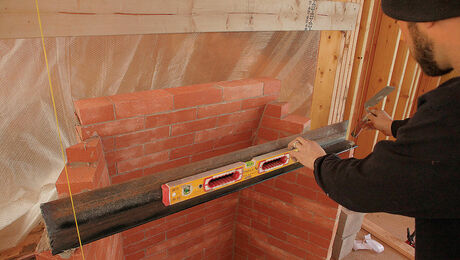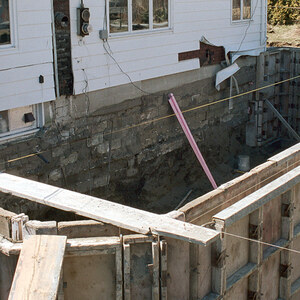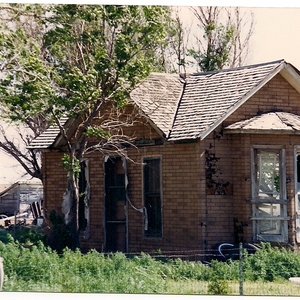Hello everyone, this is quite the hangout for useful information sans the few left jabs every now and then :^) Regardless it’s Impressive to say the least.
Question I have is can someone explain in layman terms how or if ground water affects well water production. I tried google and most of what I found was a little too complex and didn’t give me an easy straighforward answer.
Specifically: 3 adjoining building lots in a rural setting in RI. 2 lots are already built on and the 3rd is vacant. 1 lot located in a valley, is about 100′ below the other 2 and that well produces about 70 GPM. No idea as far as how deep the well or pump is. The other lot has a 500′ well and pump is about 400′. This well only produces 2 1/2 GPM according to the owner. He says it works fine for him and his wife. the only time he ran dry was when he watered his newly installed lawn. He did say it recovered quickly. The water table is about 18″ below his basement slab.
I’m trying to get an idea of what the vacant lots well might produce. I have a friend who lives in an another area with a high water table and his well produces so much that during certain times of the year, his well casing has water about 2′ from the top. He also said that a couple times it’s overflowed after a heavy rain.
With that said, why would one place with a high water table produce an abundance, while another produces so little? I know there’s more to it in regards to a deep well and how it’s fed, but doesn’t the high water table have any influence on the well production?
Thank you for any explanation or links you can provide Jack


















Replies
from my observations over the years, I'm not a driller.
Lot's of variables. 2 kinds of wells: Surface wells which are generally large diameter holes (~30") bored down to rock tha collect water that seeps down through the soil. Probably not for the depths you mentioned. Deep well has casing set down to rock and sealed (betonite (?) poured down adjacent to casing while presuure is applied to the casing from the drill rig) to prevent surface water from entering well. (critical for prevening contamination of the aquifer). The well hole is drilled down to find the aquifer. IIRC variuos types of heads through the years got different results. (Sandpoints are another type but probably not in this case.)
Rock type has a large effect on the wells performance as well. Limestone drilled without a hammer head can create a slurry that will seal off the pours in the rock preventing the water form entering the well.
The aquifer is fickle. It is independent of the surface water. This last well I had drilled we had 2.5gpm blown out from shortly after entering rock at 75'. Nothing more after that until 304' and had 85gpm blown. If they had stopped at 303 I'd be stuck with a low perfroming well. Water pressure in the aquifer pushed the level to within 45' of the surface.
if ground water is affecting a deep well perfromance you have a problem that could be serious. Surface water table should be independent of the deep well performance.
Pump types/sizes create a huge variable but as described in the OP probably not a factor.
Well drilling is more art than science when it comes to finding water.
http://www.google.com/search?q=aquifer&rls=com.microsoft:en-us&ie=UTF-8&oe=UTF-8&startIndex=&startPage=1 to get you started on aquifer.
when I did my well, I look up the county government wells on the state geo site and found one 1/2 mile from me at 80 feet that was producing, so I installed mine at 80 feet with no problems
.
two ways to screw up concrete 1) concrete driver 2) concrete finisher
The water table is about 18" below his basement slab.
Different aquifers apparently.
First do what brownbagg suggested, look at the RI web site or your county records.
WA state has a web site where you can look up every recorded well details.
Art, Curious as to your opinion of witching?
Joe H
depends which witch you dowse with.
Just like contracting, get the refs and rep first.To the OP - you do not want "ground water" feeding your well. For drinking and household use, you want a deep well so the water has been filtered and purified by mother nature in the soils it perks through.A shallow ground water well like what many were up 'til a genration ago, simply collects runoff modestly percolated through a thin llayer of soil.
Welcome to the Taunton University of Knowledge FHB Campus at Breaktime. where ... Excellence is its own reward!
like to make a point, my well is 80 feet. thats 80 feet of sand, no rock, no rock at all. although its drinkable, I just use it for the yard.two ways to screw up concrete 1) concrete driver 2) concrete finisher
thats 80 feet of sand, no rock, no rock at all. although its drinkable, I just use it for the yard
Excellent point.
For most of my county, you only need go 40-50 feet for a good dependable supply. Mind you it's the color of bad beer and has lovely aromas of sulfur & phosphorous, and a taste that "brackish" faile to accurately describe. It will keep a lawn green (and the ticks stay right away); will give funny flavors to food though.
City wells are 875 to 1275 feet deep (and there's a geothermal layer about 900-950' down, brings the water temp up to 140-145º).Occupational hazard of my occupation not being around (sorry Bubba)
How many years of using that 145 degree water in a radiant floor heat system, would it take, to equal the cost of drilling a well to 900 feet ?
Yeah, it may be cold, but at least it's a wet cold !
How many years of using that 145 degree water in a radiant floor heat system, would it take, to equal the cost of drilling a well to 900 feet
Dunno. City runs cooling towers on its three deepest (and generally most northern) wells, just to bring the muni water down to "tap" temperature.
May have to ask around; "considered wisdom" is that you need a 2-300' well out here (in the county, out of City & MUD control) for reliable potable water. For drilling, that's not bad, that's about where you start need a rock bit, so the primary cost is casing and labor.
Oh, it's been a sore tempting idea in the back of at least my head. If a person jsut wanted a "ground source" well, that could be interesting, too (especially the part about not being worried about tapping a petroleum sincline on the way down).
Oops, RFH just sank in. Going to be a long payback when heat is only needed for 8-10 weeks a year <sigh>.Occupational hazard of my occupation not being around (sorry Bubba)
8 to 10 weeks a year.I'll admit I'd forgotten that part of the equation as well.Oh well, maybe an idea for someone in a northern area...
Yeah, it may be cold, but at least it's a wet cold !
Oh well, maybe an idea for someone in a northern area
Well, I'd offer to run you a hose over there, but, I'm afraid the water would get pretty cold about half-way there (which'd be about in Marty's spring-time yard <g>).Occupational hazard of my occupation not being around (sorry Bubba)
If your 'wand' is a side-looking ground penatrating 200 kW radar, then witching works very 'well' <G>.
Own opinion is if it is a stick in someone's hand and that person does not know to look for other signs (trees, vegitation, hills, local geology knowledge, etc.) it is probably worthless.
I have a cousin who is a geologist. He can 'witch' without a wand just by looking at the landscape and vegitation - helps a lot to have the reference resources like brownbagg refered to in your head also.
There was a case in the '80's in ND, where a sargeant thought he was a great 'witcher': wires, water, gas, anything. Went out to dig up a Minuteman cable splice, his witch said 'here' - the Lt. looked up the location on the 'as-built' drawings, dwg said it was right where the witcher said. The Lt. made him use the the electronic sensor anyway just to be sure; lo and behold, the cable was actually 30 feet away!
While building one house, the well driller, the HO, and one of my henchmen all witched and hit the same spot. The well driller went first and atleast one of the others had no knowledge of what spot had been chosen. Oh yeah, we got water.
What the well produces can be entirely divergent from what you see at the surface because of the layers and folds of varying strata underground, especially in New England. you can drill and hit an underground stream that makes < 80GPM and move over twenty feet , drill even deeper and only get 5GPM or less. The only time there is a consistency is when there is a known reservoir at some certain level.
Welcome to the
Taunton University of Knowledge FHB Campus at Breaktime.
where ...
Excellence is its own reward!
Well stated.
;-) The same applies to the coast range of Or.. Neighboring wells may vary greatly in depth, flow and quality of water. One may have great flow and good water while an adjacent well may produce sulfur, or salt water . The underlying rock strata makes the difference.
They can't get your Goat if you don't tell them where it is hidden.
My driller likes to tell the story about drilling a 200' hole with 12 gpm and finding out afterwards that it was 48' from a swimming pool and in this county it needs to be 50' to pass code so they moved over 3 feet and drilled again and went 500' and hit 1.5 gpm pulled up and went over another three feet and went down 300' and had 6 gpm . all three holes had different static levels.
We used to use water witches (my current wife is one) but stopped after hitting 20GPM of muddy water at 75 feet and having to pull the 20' casing and over drill to set an 80' casing to block out the muddy water and then drilled down to 350' to hit 3 gpm of clean water.
Water is very hard to predict. a geologist is your best bet.
------------------
"You cannot work hard enough to make up for a sloppy estimate."
Thank you everyone for the explanations. If I understand what's been said, then I shouldn't be alarmed that this one well only puts out a couple gallons. I mistakenly assumed this vacant lot would be similar. I'll look up the RI site and see if I can find out more details. I'll also try to locate a local driller or geologist and see what they can tell me.
The wikipedia site was very helpful, thank you very much.
I found something else out today while visiting the area. The water from the wells in this area contains iron and there is a considerable amount of ledge to be dealt with. Should I be concerned with either other than adding a water treatment system and possibly blasting to put in a foundation? Does the ledge contribute to the iron contamination?
Thank you again for the help Jack
The water from the wells in this area contains iron and there is a considerable amount of ledge to be dealt with. Should I be concerned with either other than adding a water treatment system and possibly blasting to put in a foundation? Does the ledge contribute to the iron contamination?Ledge is good for the driller because it gives him something solid to grout his casing to. Any well over three gallons a minute will probably be fine for your residential needs so long as you don't go overboard with the irrigation. Depending on how hard the ledge is you may be able to break it up with a jack hammer attachment on a track hoe or even crush it with a large track loader. I would avoid blasting if possible in a neighborhood for fear of pissing off the neighbors. Iron in the water is annoying, plan on a water softener to remove it. M------------------
"You cannot work hard enough to make up for a sloppy estimate."
Sorry in advance for the long winded explanation, hope this helps.The success of the well has everything to do with the geology and its completion by the well driller. More on this later.First and foremost, well production generally depends on the rock's porosity-how much pore space between grains is available to hold water and it's transmisivity-how well connected the pore spaces are able to transmit the water to the bore holes, this determines speed of recovery.Since the water table is relatively horizontal and generally follows the lay of the land and by definition, a stream is the intersection of the land surface and water table, anywhere you drill below this point you are below the water table. The question is whether the rock type holds enough and can transmit water fast enough through the small surface area of the borehole to be useful.Sandstones and other large grain sedimentary rocks are generally great aquifers, imagine how quickly an ocean wave flows through the sand at the beach. Success in granites and fine grained silt stones on the other hand often depend on hitting fractures/faults/joints. These fractures act as large conduits for water to enter the borehole assuming it is properly screened at such an interval.Successful "witching" depends not on "finding" water as the water table is generally everywhere beneath our feet, but on locating the rock properties that allow the water to flow into the well. You'll only ever hear about the successful wells witched, not the first two dry ones. That being said there are many natural tip offs expressed on the surface from vegetation types to termite mounds and other tools like remote sensing (infrared satellite imaery) and geophysics that area commonly used to help site wells. So one mans forked stick is another mans satellite. Fractures in granites are often very clear on aerial photography, siting a well at the intersection of 2 such fractures increases your odds greatly.
As others have suggested, check a local well log and see what rock type your dealing with and a local geologist/hydrologist could help with a phone call.
"... a stream is the intersection of the land surface and water table ..."
I'm not a geologist, but do you mean "spring" instead of "stream"? Certainly a stream flowing on the surface can be well above the water table, no?
My current house has been my first experience with wells. It's very frustrating. On the east side of my house is an old dug well with clear, odorless water. The water level is about 16 feet below grade. But the well is within a few feet of the septic tank and leach lines, so not useable.
In the barn, which is somewhat downhill from the house, is an old dug well with clear, odorless water about 10 feet below grade, but the level lowers dramatically during dry months.
On the west side of the house is a newer drilled well. The pump is about 23 feet below grade. The well water is potable, but smells strongly of sulfur. I've been told it's naturally occurring sulfur, rather than produced by a bacteria.
To deal with the sulfur smell, we have a chlorine injector and an extensive water treatment system. All of which has been a maintenance headache. And during the dry months, the well flow rate is often insufficient to keep up with the demands of the softening system's flushing/regeneration cycles.
Meanwhile, my neighbors fill entire tanker trucks (for farming) from their well, which is only about 20 feet deep. Pure, sweet, potable water. No sulfur.
Frustrating.
I agree, wells can be a real source of frustration. They can be so expensive, and the results are unpredictable. Ground (surface) water can equal well water if you are in a karst region. Here in Missouri, we have to be careful with surface water treatment, sewage, and landfills for that reason. My well is over 500 ft deep, and the water quality can vary after heavy rainfall. The site http://www.karstwaters.org/ has a lot of interesting information, and there are karst regions in the Northeast. On my property, they had to drill 3 times because of underground caves.
To the writer who's well could not keep up with the treatment system..perhaps a larger pressure tank would help, as a storage measure.
No, I meant "stream" not spring. It is not how most people picture it, but assuming static conditions, a perennial stream is the intersection of the water table and the ground surface. There are exceptions like flash flooding in the southwest. There are also perched water tables, and karst/limestone regions with true caverns and underground rivers, but generally we're not dealing with that.Helpful is to know your rock type. Here in NW Oregon, our groundwater table is generally within 10' of the surface. But my well is 726' deep because I'm sitting on top of lava flows that have little porosity and even less transmissivity. You have to drill until you find some layer between flows, perhaps with stream gravels that can supply your well. Once hit, the water under pressure rises a couple of hundred feet providing additional storage. Although, there are some surface springs that fed the house for 50 years until we drilled a well.Just a few miles west and our rock type changes to fine grained silt stones and mudstones(marine sediments) that have quantity issues as they are too fine grained to transmit water fast enough to the small area of the borehole and quality issues with sulfur, iron etc. If you drill too deep, you hit salt water. It's common in these areas for folks to have "Indian wells" a depression dug near a stream (often a vertical 3' perforated culvert capped and surrounded by drain rock), the water quality is better and can be treated with just a UV system and the large suface area allows the water table/stream to refill it fast enough. FYI, our state water law does not allow these depressions to be more than 12' below grade to prevent aquifer contamination. In other words, all wells below 12' must be sealed (well casing and bentonite) from the surface.It sounds like your wells are essentially surface dugouts, notorious for contamination even if only fecal coliform but used all over the world forever. They have the advantage of large surface area for quick recovery. Do you know why your drilled well is only 26' deep, that seems hardly worth the effort of drill rig mobilization etc, unless they weren't capable of drilling deeper or there is something they are trying to avoid. What is your rock type?Have you looked at an aerial photograph of your area to see if you can see any sign of why your neighbors well is such a producer? Fractures and stream valley depressions come to mind.Good luck.
Thanks for all that info. I have to admit I've done zero research; pretty much just accepted the conditions I found when I bought the place back in '95. That included a basement cistern fed from the roof gutters that supplied all the hot and cold faucets (except a second cold-water faucet at the kitchen sink, supplying potable but sulfur-smelling well water).
That worked well until a stray cat somehow got in the basement and drowned in the cistern. Didn't discover it for a few weeks, but then pumped out the cistern and discontinued it.
For some reason the well supplied the toilet, even before I switched the whole system to well water, and the house filled with sulfur smell each time it was flushed.
When I got married, my bride insisted on the water treatment system.
The geology here is sandstone and limestone, I believe. In the 19th century, there were extensive quarries in the area, supplying Medina Sandstone for buildings from Buffalo to New York City.
Yes, I suppose even my drilled well is essentially a "surface dugout." Indeed, a couple days of rain, and it recovers quickly. We use bottled water for cooking and drinking, even though the well is supposedly "potable." With such shallow wells, I imagine frequent testing would be advisable if used for drinking water.
Thanks again.
Allen
You know where I grew up.
That well was a drilled 58' well right close to the house top of the hill there.
Never a problem and to my knowledge still good today. That would put it below those 3-4 small lakes near there, all spring fed
Welcome to the Taunton University of Knowledge FHB Campus at Breaktime. where ... Excellence is its own reward!
I'm not sure how different the geology is in Wyoming County, compared to here. I know that the early settlers in my area found very few springs, although there was one on my neighbor's property (back in 1816). The first settler here dug a pond at the spring, using it as a water supply, and for ice harvesting in the winter.
That spring no longer exists.
The land up here is generally very flat, with clay soils. There were extensive swamps in some parts of my town until a system of canals and drainage ditches were excavated in the late 19th century.
Allen
Edited 1/28/2008 7:25 pm ET by WNYguy
I have listenedto well drillers on houses we frame. Their opion in NYS that no matter were you drill you will hit water. had a house in rome that had 42' drilled well smelled like sulfer. next door , my brother in law had 45' well no sulfer. They drilled for there pool 35' sulfer water, oh by the way surface water? said the well driller, kept drilling 102' hit water again with shale(?) smelled like sulfer. Mother in law, next door, had sulfer water. We used to put in open milk jug overnite, sulfer gone tasted great. I,personal observation, well drillers drill as long as pockets have cash, then 10' more.
Thank you again everyone, I learned a lot from what's been posted here and a bit of reading elsewhere on the web. I'm still undecided with buying this property. I spoke with a driller who is familiar with the area and he said I could probably expect somewhere in the neighborhood of 6-10 gpm, maybe more. His explanation for the low producing well was the same as what a few of you have said and they should have tried another spot. Same with the iron, not a big concern and a treatment system would take care of it.
However the ledge could be a deal breaker. I might be looking at as much as $10,000 for the blasting to put in a basement. That hurts!!
It doesn't matter who you talk to, everybodys'opinion will be different, even the well drillers.
This my experiences in the past, personal and professional, all being for the arid areas of SoCal.
Where we used to live, a neighbor had a well not more than 100 feet away from the one we were drilling. At 550ft, the had 2 1/2 gpm. we were at 625' and just over a 1gpm. We went to 750 and had 5-7gpm and at 884' we were around 10gpm.
Another neighbor was at 770' and had less than 1 1/2 gpm. Theirs was about 330 ft away from ours. They were constantly sucking sand and our water was crystal clear with fractured granite almost all of the way down. The other neighbor's water had heavy iron content and much of the drilling was solid granite.
About 5 years after we had our well drilled, many of the wells in the valley were having a problem with their wells drying up. These were typically 250-500 ft deep.
Many blamed the decrease on the giant reservoir that was going in. Claims that they broken the underground flows. Others blamed it on too many people trying to take too much from the Earth, especially the local water districts
Ours never slowed down, even after a 18 hour pump test..
Other homes that I worked on, wells rates in the 40gpm and after the owners started irrigating 10-20 acres of lawn, their wells would pump dry
My understanding of this whole process is that most people look to the topography and try to make a decision as to where to drill. Some feel that a drilling in the lowest areas is cheaper because you have to drill less depth. What i have been told is that this is some of the worst places because of surface runoff/contaminatio whicjh is why my jurisdictions require a sanitary seal anywhere from 20-60 deep. The guessing game is trying to figure what the terrain is like 100'-1000' below the surface
As for witching a property, that to me is pure unexplainable vodoo. I had a guy that does magnetic imaging do a profile on our properry and he picked an area that had high megnetic disturbances which supposedly meant areas of highly fractured rock. this also what makes the witching rods move... supposedly. This is where we chose to drill. It also witched well in that area too. Well, he or some one was right or we were real lucky. Even the driller was amazed. One of the drilling owners wanted to move the rig and try another place, the other said to keep drilling in the same place. This is the first time that they had ever used an Imaging service and they had never hit that much fractured rock in one hole.
I'm still not a believer in it because how can they really tell where and how deep the fractures are and is there water in those fractured areas? My belief is that the deeper you go, the better the odds.
But what do i know...
Edited 1/28/2008 8:35 pm by migraine